Nightlife in Lisbon and in Porto
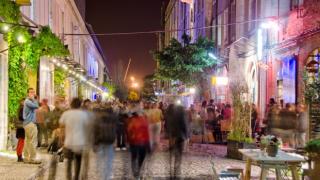
Portugal by... Condé Nast traveler
When dusk stretches its mantle over the city of Seven Hills, when the litany of squealing trams gradually dies down, Lisbon prepares to show its most versatile and eclectic side. Because night-time in the Portuguese capital is full of possibilities capable of satisfying the most demanding night owls: terraces to chill out, from where it is possible to admire the magical palette of colours in the evening sky, dancing in nightclubs to the latest electronic music from Europe, meeting artists in industrial spaces in the purest style of Berlin or immersing oneself in the Portuguese culture of fado and "saudade" in traditional but modernised fado houses. All this is possible in this city that may seem melancholy during the day, but is cheerful and vibrant like few others by night.
Cais do Sodré, the Bohemian night
An area formerly littered with brothels and gambling houses where sailors went for a night of delight and a pair of arms in which to lose themselves after the hard months at sea, it has now been transformed into one of the most vibrant night spots in Lisbon.
The epicentre of this old/former Red Light District is Rua Nova do Carvalho, a street whose provocative garish pink-painted asphalt is home to a variety of unique and unusual places where you can watch a burlesque show, drink a cocktail whose name would shock our mothers (such as "chic whore"), eat some Portuguese tapas between drinks or watch an innovative live concert.
The night is vulgar, sensual and original on the pink asphalt, but also versatile and diverse. One of its greatest exponents is Pensão Amor (Hostel of Love), an old hotel whose rooms used to be rented by the hour by prostitutes and sailors, that has been converted into a multidisciplinary space where you will find, amongst others, an erotic bookstore, a sexy lingerie boutique, a hairdresser (Facto Fetish) cutting hair for to "students, sailors and lady-tramps" and an arts bar. In this lively café it’s possible to do everything from contemplating the ceiling paintings that emulate the Sistine Chapel, to enjoying a good Peruvian ceviche with a glass of wine.
Bairro Alto: the first drink
A quaint district like few others that has for decades undoubtedly been the place to meet for the first drink of the evening. In the lively cobbled streets of this Lisbon neighbourhood the tradition is to order a caipirinha or caipirosca and drink it in the street, enjoying the mild temperatures (although even when it’s cold, the ritual is carried out with the same mathematical precision).
In Rua da Barroca, Clube da Esquina (Rua da Barroca 30-32) is a bar with a cult following, which they say serves the best mojitos in town.
Besides caipirinhas and good music, Bairro Alto also offers other attractions to enliven the warm evenings, with various designer boutiques and "concept stores" whose doors stay open until the early hours.
And on summer nights, nothing can beat one of the terraces of any of the area’s hotels, such as the BA Esplanade at Hotel Bairro Alto. This has been praised as the fourth best view of the world from a hotel terrace, and offers a stunning panoramic city view with the River Tagus as a unique backdrop.
LX Factory, hipster Lisbon
This is the new mecca of alternative and Bohemian culture in Lisbon, the preferred spot for intellectuals, artists, and/or those looking for something original and different. Under the 25 de Abril bridge, in the middle of the Alcântara neighbourhood, in the 19th century this complex housed one of the most important manufacturing industrial zones in the city (it was the headquarters of the Companhia de Fiação e Tecidos Lisbonense) and has been transformed into a real experimental factory.
Christened the LX Factory (LX is an acronym for Lisbon), it comprises 23,000m2 of previously abandoned buildings, which seamlessly merge creativity and the industrial spirit of the area. It is a true city within the city. During the day, it’s a vibrant centre filled with shops, cafés and restaurants, artists’ workshops and businesses. At night it’s a catalyst for cutting-edge trends and the more alternative sounds. Don’t expect sophisticated decoration: here, decadence and industrial style are the hallmarks of the house.
The sensation of the season is Funky (Edifício H), a space in which you can drink and listen to live DJ music, recently opened by one of Lisbon's great nightlife celebrities, Hernâni Miguel.
Alfama, the modern fado experience
There is nothing more Portuguese than the melancholy, profound fado singing which was born, it seems, in a tavern in the Alfama neighbourhood. This was in the 19th century, and the notes imbued with nostalgia and heartache of a music that is all about hopeless love and longing have become one of the icons of Portugal. Currently, fado remains inseparable from the essence of Alfama and it is here, among the alleyways, cobbled pavements and decaying Moorish houses, that you can find the best places to hear it.
A new generation of fado houses has recently emerged that, without losing its essence, offer a more up-to-date folkloric experience, of better quality and much more entertaining. These temples of fado are increasingly frequented by the people of Lisbon and are a crucible for artists and young professionals looking for a piece of the Portuguese soul.
One of our favourites is Sr. Fado (Rua dos Remédios 176, Alfama), owned by the fado singer Ana Marina and guitarist Duarte Santos, where you can enjoy a fantastic traditional Portuguese cuisine, while listening to good quality fado. A family atmosphere, warm hospitality and a perfect environment to understand a little more of Portuguese culture.
Avenida 24 de Julho and Santa Apolónia, a time for Clubbing
Lisbon has enjoyed a well-deserved reputation since the 1990s as one of Europe’s avant-garde cities when it comes to clubbing. The city offers a wide repertoire of options ranging from those that provide lounge, house and electronic music sounds. Avenida 24 de Julho and Santa Apolónia are the most modern dance hot spots in the capital.
Lux is in Santa Apolónia, a club that has topped the European rankings of the most reputable clubs for years. And proof is something there is no lack of: one of the owners is the actor John Malkovich, and Lux has been visited by, amongst many others, movie and music stars such as Cameron Diaz and Prince. Funky, retro furniture completes the impressive interior décor which is divided into two very distinct ambiences: on the ground floor, the exciting dance rhythms on the dance floor are the left to top DJs mixing the latest and greatest tracks; upstairs, a much more relaxed atmosphere, ideal for a drink in good company. Queues at the entrance and rigorous entry criteria are the drawbacks of what is probably the reference spot on Lisbon’s night scene.
On Avenue 24 de Julho, "Main" deserves a mention. This replaced the mythical "Kapital" which reigned supreme in Lisbon’s nightlife for more than two decades. Young people (20s and 30s) and intense weekends in a place that reinvented itself into various spaces and environments.
Príncipe Real: Lisbon’s gay scene
In 2010, Portugal became the sixth European country to approve same-sex marriage. Since then, the capital has enthusiastically celebrated its "gay pride" with the opening of several spaces dedicated to this audience, a community that is notable amongst the artistic and professional world and an atmosphere that effusively celebrates tolerance and respect. For some, Lisbon is now a major destination for the gay community.
The area around Principe Real is the nerve centre of the capital’s new gay scene, which recently saw the inauguration of several places dedicated to this community. One of the streets adjacent to the square, Rua Cecílio de Sousa, is known as the Chueca of Lisbon.
This is where the club "Construction" can be found. This club is mainly directed to the gay segment known as "Bears", but has been widely acclaimed throughout the gay community and is currently attended by a diverse and heterogeneous audience.
PORTO’S NIGHTLIFE
The revamped Porto nightlife scene is a perfect combination of the overflowing enthusiasm of its inhabitants for art and design and the frenetic rhythms of a vibrant and endless night. In the old Douro city the night sparkles, it’s magical and above all social. Here you will never feel alone, because the “Portuenses” always do justice to their well-deserved reputation as night-time revellers and hospitable people and are ever ready to reveal the secrets of one of the most exciting night-time scenes in Portugal.
Baixa, the latest nightlife revolution
This area of the city that had until recently been completely ignored and forgotten by night-owls, has now become one of the most exciting night spots in Porto. Baixa, which forms the historic downtown centre with monuments such as the famous S. Bento station and the Clérigos tower, is currently the epicentre of the new Porto nightlife, thanks to the impetus of a group of artists and entrepreneurs determined to give a new look to the old city.
The nightlife revolves around two parallel streets, Rua Galeria de Paris and Rua Cândido dos Reis. Spread throughout both streets there are dozens of bars sought after by those wanting their first drink: various types of caipirinhas, reinvented cocktails based on port wine or simply a Super Bock (the city’s beer and something of great pride for the Porto people) are the locals’ preferences. One of the most popular bars, the Bar Baixa (Rua Cândido dos Reis, 52), recreates the atmosphere of the elegant and sensual Parisian Bohemia, at whose bar Cosmo Porto, a clever combination of port wine, Cointreau and red fruit juice, always delights the patrons.
As the night progresses, the music starts to become more sophisticated, reggae, house, and electro and the dance floors begin to fill. You don’t need to walk far, because several houses in the area offer programmes where music and art combine perfectly. One of the busiest is PLANO B- (Rua Cândido dos Reis, 30). Located in a former textile factory, this is one of the most innovative clubs on the Porto scene. This multidisciplinary space was opened in 2007 with a very clear goal: to create a new centre of culture and entertainment in the downtown area. With retro décor, the place is divided between two floors. Upstairs there is a room for art exhibitions and a café with Wi-Fi. Downstairs there are different spaces that offer an eclectic programme, with musical performances of various genres and other artistic expressions.
Ribeira, the soul of Porto
With its amalgam of mediaeval cobbled pavements, its crumbling ochre buildings and its picturesque atmosphere, Ribeira, bathed by the River Douro, is the most photogenic image in Porto and one of the most fascinating in the city. Classified by UNESCO as a World Heritage Site, it is impossible not to sit in one of its many terraces in the evening, with a glass of good wine in your hand (preferably port wine), contemplating the boats that descend slowly down the river, passing under the impressive D. Luis I bridge, which connects this area to Vila Nova de Gaia, and is the work of a disciple of Gustav Eiffel.
Ribeira is the perfect place to start the night in one of its many bars situated on the banks of the river. The Quay Wine Bar (Muro dos Bacalhoeiros, 111 and 112), which has a fantastic view over the Douro is, according to Trip Advisor, the most popular bar-restaurant in Porto. Managed by Filipa Fernandes, it has been in the family for over a hundred years and manages to combine in the same place the family tradition and an innovative concept of English origin called "wine by the flight" that enables you to taste three different wines from the region.
Later you will find bars with extended opening hours hidden away in the most unlikely places and seemingly deserted squares. And while Ribeira is the place for those who want to start the night early, there are also suggestions for those who choose to end the night on the bank of the mystic Douro, such as ANIKI BOBO (Rua de Fonte Taurina, 36-38). This sophisticated space for music and alternative culture is located in a 17th century building whose interior has three areas with diverse atmospheres. The curious name comes from the Portuguese classic movie of the 30s with the same title. It is frequented by an eclectic clientele and is one of the most interesting night scenes in Porto.
Foz do Douro, dancing the night away on the seafront
This exclusive area of Porto has a cool and relaxed atmosphere thanks to its prized location where the River Douro meets the Atlantic Ocean. In this area you can also find the Fort of São João Baptista, a fortification built in the 16th century to protect entry to Porto via the river. Dotted with boutiques, age-old taverns where you can indulge yourself with some excellent fish, trendy restaurants and chill out-style bars for "snacking" on something at any time of day, Foz is also known as the home of some of the city’s most prestigious clubs, the place where night-birds come running at night looking for its great atmosphere and music to dance to until dawn.
One of the places that has been a cult in Porto for over fifteen years is Indústria at Avenida Brasil, 843. Recently restored, this club attracts an average of 1,000 people every weekend, all making restlessly for the dance floor, with DJs of national and international renown.
Matosinhos and Porto’s Industrial Zone: the new wave
The adjacent city of Matosinhos is another favourite gathering point for night owls determined to end the evening only when the sun rises in the morning sky. Even if you have to travel by car or taxi, the half-hour journey justifies the effort because of the diversity of clubs in the area. Varied environments (theme nights are the speciality and Ladies Night, with free entry for them, is one of the most popular) and the clientele is mixed, despite the special emphasis on university students.
One of the night-time references in Matosinhos is Estado Novo (Rua Sousa Aroso 722) designed by Siza Vieira, the architect, amongst others, of the Museum of Contemporary Art at the Serralves Foundation and one of Portugal’s greatest living architects. The club is above a former foundry and maintains some of the original features, such as a bridge. Theme nights dedicated to young people or their parents bring people to a place where electronic music shares the stage with the latest rock rhythms.
Outside Foz and Matosinhos, in recent years the old industrial zone of Porto has been developed as an area of nightclubs and bars. Two of the most popular places, with completely different styles, are found on Avenida Fontes Pereira de Melo: Movida Beach, with Afro-Cuban, Latin and Brazilian music in a crowded club frequented mainly by students willing to try anything; and on the same street, and targeting a more mature audience, there’s Vogue (mainly for house music).


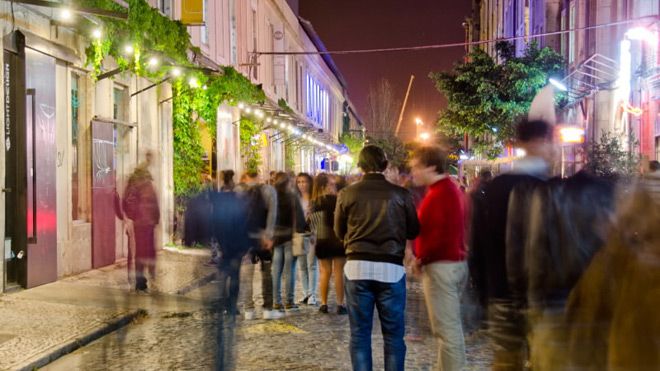















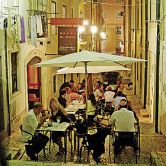
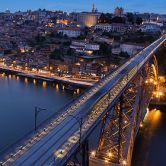

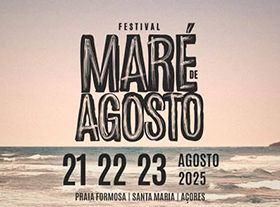
 Explore
Explore 
 Remember and Share
Remember and Share 


